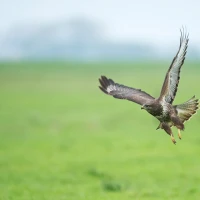Hawk legs might seem like a narrow subject on the surface, but there is a world of wonder and intrigue when you delve into the specifics of these raptorial appendages. Birds of prey are known for their extraordinary hunting abilities, sharp eyesight, and formidable talons. But specially designed legs play a crucial role in their hunting prowess and survival. In particular, the Red-tailed Hawk and the Rough-legged Hawk have leg features that astound bird enthusiasts and scientists alike.
The slender, powerful limbs of these avian predators are instrumental in their hunting strategies. Their ability to perch effortlessly, soar, and pounce on prey with precision showcases the adaptability and evolution of their legs. Throughout this article, we will embark on an exploratory journey, examining the utility and characteristics of hawk legs, including the subtle nuances that distinguish different species including the Red-tailed Hawk and Rough-legged Hawk.
In our excursion into the birding depths, we will also take a virtual tour through the Rough-legged Hawk range map and compare the Rough-legged Hawk vs Red-tailed Hawk. As we scrutinize the juvenile Rough-legged Hawk and other developmental stages, we will appreciate the functionality and beauty imbued in these birds of prey. So, prepare to have the mystery of hawk legs unveiled, and discover the secrets behind their undeniable hunting prowess.
The Anatomy of Hawk Legs: Foundation of a Predator
When we consider the hawk legs size, it’s not just the length we’re reflecting on. It’s their overall design that makes them powerful tools for survival. The legs of a hawk can tell us a lot about their lifestyle, including their hunting habits and the type of prey they favor.
Musculature and Bone Structure: The Framework of Strength
The legs of hawks are composed of a robust skeletal structure, enveloped by a specialized musculature. This combination allows them to firmly grasp their victims with a strength that far exceeds their own body weight. The muscles, particularly the flexor muscles that control the talons, are capable of snapping shut with impressive force. This closing action is involuntary, making the talons a highly effective trap for securing prey.
Talons and Retraction: Instruments of Capture
One cannot discuss hawk legs without admiring their extraordinary talons. A hawk’s talons are sharp, curved, and deadly; they can easily puncture and hold struggling game. This raptorial grip is further improved by the retractable feature—like a cat’s claws—allowing for the fine-tuning of their grasp depending on the prey’s size and movement.
Feathers and Scales: Protection and Camouflage
The feathers that extend down many hawk legs are not merely for show. They offer insulation against harsh weather conditions and aid in camouflage while hunting. Beneath these feathers, the scales on a hawk’s legs protect against the bites and scratches of prey, functioning similarly to a suit of armor.
The Distinctive Hawk Legs Identification Guide
Hawk legs are as unique as fingerprints, serving as reliable identifiers for various species. Their color, size, and even feather patterns are distinctive, facilitating their identification from a distance.
Red-tailed Hawk Legs: Signature of A Common Predator
The Red-tailed Hawk legs display characteristics typical of a versatile hunter. These birds, known for their iconic reddish tail, also have powerful legs with a telltale spectrum of coloration ranging from yellow to a dark, almost brownish hue. The legs of a Red-tailed Hawk signify its adaptability as these hawks feed on a wide variety of prey—from small mammals to reptiles and even other birds.
Rough-legged Hawk: Specialized for Cold Climates
On the other hand, the Rough-legged Hawk features legs that are feathered all the way down to the toes. This distinctive trait allows it to endure the frigid conditions within its habitat. The feathered legs also offer insight into its name—“Rough-legged” stemming from the textured appearance of their legs.
Visual Guide to Hawk Habitats: Exploring The Rough-legged Hawk Range Map
A closer inspection of the Rough-legged Hawk range map discloses a bird that is a true wanderer of the northern latitudes. Rough-legged Hawks breed in the Arctic tundra and migrate south to spend the winter in open fields and marshlands across North America.
Migration Patterns and Wintering Grounds
Understanding the Rough-legged Hawk’s migratory patterns is essential for conservation and study. Their range varies with the seasons, and the map illustrates the band across the continent where you might witness these majestic birds during different times of the year.
Comparing Sky Hunters: Rough-legged Hawk vs Red-tailed Hawk
The Rough-legged Hawk vs Red-tailed Hawk comparison yields fascinating differences in their ecology and adaptation. While both species are exceptional hunters, their leg and talon adaptations have evolved to match their respective environments and prey selection.
Feathering Differences: Weather Adaptation
The feathered legs of the Rough-legged Hawk serve as an adaptation to arctic temperatures, while the less feathered legs of the Red-tailed Hawk suit its more temperate range.
Prey and Hunting Techniques
Red-tailed Hawks generally exhibit greater flexibility in their prey choice, capturing small mammals with speed and agility. Rough-legged Hawks, conversely, often hover in search of rodents beneath the snow, a strategy supported by their long feathered legs’ insulating properties.
The Lifecycle and Development of the Juvenile Rough-legged Hawk
Examining the Rough-legged Hawk juvenile phase provides a window into the growth and maturation of these birds. The youngsters display lighter, fuzzier plumage on their legs, which gradually acquires the full adult feathering as they age.
Growth Stages and Molt
As young Rough-legged Hawks grow, they molt their feathers periodically. This includes the feathers on their legs, which transition to the stiffer, more protective adult version. Observing these changes in plumage can help with age identification in the field.
Training for the Hunt
The developing leg strength and talon sharpness are crucial for juveniles learning to hunt. Through practice and instinct, they hone their skills, strengthening their grasp and enhancing their ability to capture and dispatch prey.
Conclusion: The Wondrous World of Hawk Legs
The investigation into Hawk legs size, Hawk legs identification, and the specific traits of species like the Red-tailed Hawk and Rough-legged Hawk reveals the exquisite design of nature. Throughout this exploration, we have discovered that hawk legs are masterpieces of evolutionary engineering, each feature crafted for survival and efficiency in the wild.
Bird enthusiasts, scientists, and conservationists alike marvel at these adaptations—not only for their functionality but also for the ethereal beauty they add to these powerful predators. Whether viewed through binoculars in the field or studied in academic research, the intrigue of hawk legs remains one of the compelling aspects of avian biology.
The next time you find yourself gazing up at a circling hawk or watching one perched atop a lamp post, take a moment to appreciate the hidden secrets just beneath their plumage. The anatomy, physiology, and sheer diversity of hawk legs are not merely support structures; they are defining characteristics that elevate these birds to the apex of aerial mastery. Bronze Anniversary Gifts for Him
Understanding and appreciating the minute details that differentiate the Red-tailed Hawk from the Rough-legged Hawk and acknowledging the uniqueness of the juvenile Rough-legged Hawk can enrich our respect for these astounding creatures. As we uplift our knowledge and admiration, we contribute to the preservation of their habitats and the continued splendor of the avian kingdom.










